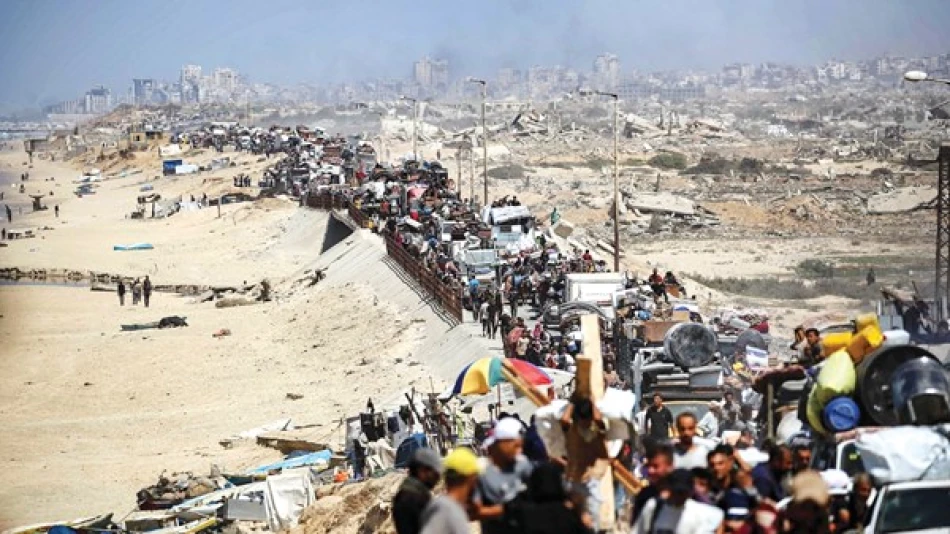
Israel Intensifies Ground Assault in Gaza as Thousands Flee the Conflict
Israel Escalates Gaza City Assault as Displacement Costs Soar to $3,180 Per Family
The Israeli military has announced preparations for an "unprecedented" assault on Gaza City, forcing another wave of mass displacement as nearly half a million residents flee southward. With displacement costs reaching over $3,000 per family and malnutrition deaths climbing to 440, the humanitarian crisis deepens as Israel intensifies its campaign in the territory's most densely populated urban center.
Military Escalation Targets Gaza's Population Hub
Gaza City, the strip's largest and most populous urban area, faces what Israeli military officials describe as an assault of "unprecedented force." The city, which housed over one million residents according to UN estimates from August, has already seen approximately 480,000 people displaced in recent days as ground operations intensified following last Tuesday's offensive.
Israeli military spokesperson confirmed that forces "will continue operating with extreme and unprecedented force," restricting movement to a single southern route via Al-Rashid Street. The announcement represents a significant escalation in an already devastating conflict that has systematically dismantled Gaza's urban infrastructure over nearly two years of warfare.
Strategic Implications of Urban Warfare
The focus on Gaza City reflects a broader military strategy targeting the territory's administrative and population centers. Unlike previous operations that primarily affected border areas or specific neighborhoods, this assault targets the heart of Palestinian urban life in Gaza, where displaced families from northern towns had already sought refuge.
Economic Warfare Through Displacement Costs
UNRWA has documented the staggering financial burden of forced displacement, with families facing costs of $3,180 to relocate from Gaza City to the south. This figure breaks down to $1,000 for transportation, $2,000 for a family tent, and $180 for land rental—amounts that represent impossible sums for a population cut off from income sources for nearly two years.
These costs effectively weaponize displacement, creating economic barriers that trap families in active conflict zones. The pricing structure suggests a collapse of normal market mechanisms, with scarcity driving transportation and shelter costs to levels that exceed many families' lifetime savings.
Systematic Infrastructure Collapse
Gaza City's municipal spokesperson confirmed the "near-complete collapse" of basic services infrastructure, with widespread destruction compounding civilian suffering. The systematic degradation of utilities, healthcare, and transportation networks represents a form of economic warfare that extends far beyond immediate military objectives.
Humanitarian Crisis Reaches Critical Threshold
Palestinian health authorities report malnutrition-related deaths have reached 440, including 148 children, with four additional deaths recorded in the past 24 hours. Since the Integrated Food Security Phase Classification declared famine conditions in Gaza last August, 162 people have died from malnutrition, including 33 children.
These figures indicate a systematic breakdown of food distribution networks that goes beyond typical wartime shortages. The sustained nature of malnutrition deaths suggests deliberate policies designed to make civilian life unsustainable rather than temporary disruptions from military operations.
International Precedents and Legal Implications
The scale and systematic nature of displacement in Gaza City parallels historical cases of urban warfare, but the economic barriers to civilian evacuation represent a novel element. International humanitarian law requires parties to conflict to facilitate civilian evacuation, but the $3,180 cost effectively creates insurmountable obstacles for most families.
Regional and Global Consequences
The Gaza City operation signals a new phase in the conflict that prioritizes territorial control over population management. Unlike previous cycles of violence that followed patterns of escalation and de-escalation, the current assault appears designed to permanently alter Gaza's demographic and urban landscape.
For regional stability, the systematic displacement of Gaza City's population creates precedents for urban warfare that could influence conflicts across the Middle East. The integration of economic warfare with military operations represents an evolution in siege tactics that other regional powers are likely studying closely.
The unprecedented scale of displacement costs combined with systematic infrastructure destruction suggests this operation aims for permanent demographic change rather than temporary military advantage. As families face impossible choices between remaining in active combat zones or paying prohibitive evacuation costs, the humanitarian crisis in Gaza enters uncharted territory with implications extending far beyond the immediate conflict.
Most Viewed News

 Layla Al Mansoori
Layla Al Mansoori






